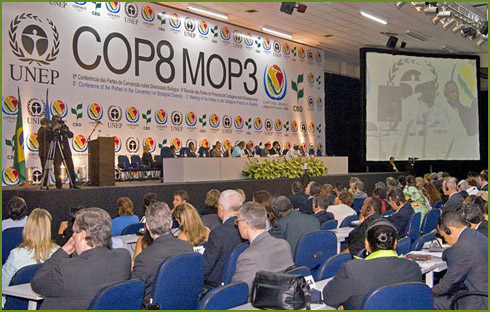The goals of CBD
see documents below:
http://assets.wwfbr.panda.org/downloads/metas_de_aichi_situacao_atual_no_brasil__2011_download.pdf
http://www.cbd.int/doc/world/br/br-nr-04-pt.pdf
Defining goals is an important tool for assessing the achievement of given targets. CBD defined a set of goals for the period 2002 – 2010. The strategic planning for implementation in a national, regional and global level, aiming at reducing the loss of biodiversity and equal sharing of benefits, had been elaborated. Unfortunately the plan showed out to be inefficient. According to the „Global Biodiversity Outlook“, the goals of the Convention could not be achieved (Secretariat of the Convention on Biological Diversity, 2010a, p. 8).

- Species which have been assessed for extinction risk are on average moving closer to extinction;
- The abundance of vertebrate species, based on assessed populations, fell by nearly a third on average between 1970 and 2006, and continues to fall globally, with especially severe declines in the tropics and among freshwater species;
- Natural habitats in most parts of the world continue to decline in extent and integrity, although there has been significant progress in slowing the rate of loss for tropical forests and mangroves, in some regions;
- Crop and livestock genetic diversity continues to decline in agricultural systems;
- The five principal pressures directly driving biodiversity loss (habitat change, overexploitation, pollution, invasive alien species and climate change) are either constant or increasing in intensity;
- The ecological footprint of humanity exceeds the biological capacity of the Earth by a wider margin than at the time the 2010 target was agreed (Secretariat of the Convention on Biological Diversity, 2010a,);
So why targets and strategic planning continue to defined? In spite of the worldwide failure in achieving the principle goal, global action could not minimize loss of biodiversity. However, action to implement the Convention on Biological Diversity has not been taken on a sufficient scale to address the pressures on biodiversity in most places. There has been insufficient integration of biodiversity issues into broader policies, strategies and programmes, and the underlying drivers of biodiversity loss have not been addressed significantly. (Secretariat of the Convention on Biological Diversity, 2010a, p. 10);
Brazil, in 2006, defined 51 biodiversity targets, according to the global targets of the Convention and partially exceeding it. The national targets were confirmed by the Nacional Council of Biodiversity (Conabio) in 2006 and published by the Conabio Resolution Nr 3.
Even having expanded the protected areas and reduced logging significantly, out of the 51 nationally defined 2010 targets only 34 (6%) showed a result in 25% or less (BRASIL/MMA; 2010). Two of the targets were achieved completely: reduction of fire sources in 25% and making disposable species lists in permanent data bases.
Brazil plays an important role in the definition of the Aichi-goals – ambitious, but severely concerned about feasibility. It continues important to integrate the frustrating 2010-goals experience into the planning process of the 2020-goals and thus invest in a realistic planning, referring to intermediate targets and deadlines, as well as long term evaluations.
The Strategic Plan contains the following elements:
Logical basis: associates biodiversity with human well-being, with the Millennium Goals and Poverty reduction.
Vision: By 2050, biodiversity is valued, conserved, restored and wisely used, maintaining ecosystem services, sustaining a healthy plant and delivering benefits essential for all people.
Mission: take effective and urgent action to halt the loss of biodiversity in order to ensure that by 2020 ecosystems are resilient and continue to provide essential services, thereby securing the planet's variety of life, and contributing to human well-being, and poverty eradication. To ensure this, pressures on biodiversity are reduced, ecosystems are restored, biological resources are sustainably used and benefits arising out of utilization of genetic resources are shared in a fair and equitable manner; adequate financial resources are provided, capacities are enhanced, biodiversity issues and values mainstreamed, appropriate policies are effectively implemented, and decision-making is based on sound science and the precautionary approach.
Implementation, monitoring, review and evaluation: comprise means for implementation, programmes of work, broadening political support, partnerships, reporting by parties.
Support mechanisms: comprise capacity-building for effective national action, clearing-house mechanism and technology transfer, financial resources, partnerships and initiatives to enhance cooperation, support mechanisms for research, monitoring and assessment.
The Strategic Plan 2011-2020 (Aichi) schedules five strategic goals, as follows:
A: Address the underlying causes of biodiversity loss by mainstreaming biodiversity across government and society
B: Reduce the direct pressures on biodiversity and promote sustainable use
C: To improve the status of biodiversity by safeguarding ecosystems, species and genetic diversity
D: Enhance the benefits to all from biodiversity and ecosystem services
E: Enhance implementation through participatory planning, knowledge management and capacity building